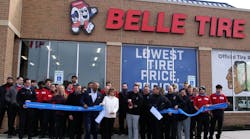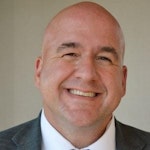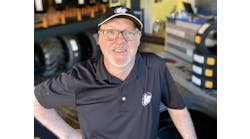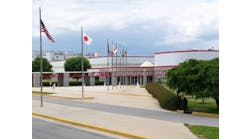‘Default Yes’ Mentality Supercharges Belle Tire’s Growth
Allen Park, Mich.-based Belle Tire Distributors Ltd. - which is celebrating its 100th anniversary this year - is one of the fastest growing independent tire dealerships in the United States. And its expansion has accelerated within the last decade.
Fifty of Belle Tire’s 140 outlets have been added over the last seven years. And the company plans to open 60 more stores in one market alone - Chicago, Ill. - within the next two-and-a-half years.
The secret to the dealership’s recent growth and overall success is simple, says Don Barnes III, Belle Tire’s president. (His father, Don Barnes Jr., and uncle, Bob Barnes, own the company, which has enjoyed consecutive years of double-digit growth.)
“In terms of how we go to market, it’s always customer-centric,” says the younger Barnes, who joined the dealership in 2000. “We understand that our job is to get our neighbors back on the road and give them peace of mind. That’s always been the basis of what we do. We try to keep it simple and approach it like that.”
History of growth
Belle Tire was founded in 1922 in Detroit, Mich., by Sam Waze. In the 1960s, Don Barnes Sr., a Kelly-Springfield Tire Co. representative who had been selling tires to Belle, decided to partner with the Waze family and bought into the dealership.
The company began to grow, adding several new stores across Michigan.
The Barnes family took full ownership of Belle Tire in 1984 and continued its expansion via the acquisitions of several other Michigan-based independents, including American Tire, Delta Tire, Great Lakes Tire and Elkin Tire.
In 1994, Belle Tire acquired three Tireman locations in the Detroit area, “which pretty much doubled our size overnight,” says Barnes. Belle Tire owns the Tireman name in Detroit. A separate dealership that bears the Tireman name, Tireman Auto Service Centers LLC, is based in Toledo, Ohio, and has 20 retail locations in that market.
In 1997, Belle Tire acquired Metro 25, a longtime Detroit-area tire dealership that had 10 stores, giving the company 45 total locations.
Barnes cites the Tireman and Metro 25 acquisitions as being pivotal, but for different reasons. Tireman’s “color scheme and brand was red, white and blue, so when we acquired Tireman, we had a complete rebranding — moving from our old-school block letters and brown/khaki colors to red, white and blue. That was one of our most significant acquisitions because it really reshaped our brand.”
The purchase of Metro 25 “really solidified us as being Detroit’s dominant tire retailer and is what catapulted us into growing organically throughout Michigan.”
Other acquisitions followed, including the purchase of National Tire & Battery locations in the Detroit area. And in 2003, Belle Tire ventured outside of Michigan for the first time, expanding into northwest Ohio with three stores in the Toledo market.
Belle Tire continued its steady growth trajectory. In 2015, it entered a new market, Indiana, which was the springboard to the dealership’s biggest growth surge.
“All of our growth from 2000 has been organic,” says Barnes. “We want to control our own destiny. We want to make sure our new locations are in premium locations on the corner of Main and Main. We want to be where people are and where development is.
“It’s not about planting flags on the ground. We would rather control our destiny and control our culture and make sure we cherry-pick the right people to be on our team.”
Two more major markets
Belle Tire opened its first “Hoosier State” location in South Bend, Ind., and then moved south to Ft. Wayne and markets that are closer to Indianapolis.
Barnes says Belle Tire management considered Indiana to be a “fragmented market” at the time, “so looking at how we operate, we felt there could be a great opportunity to move in.”
Today, Belle Tire has 37 locations throughout the central and northern parts of the state.
Several of those are along Interstate 465, which surrounds Indianapolis, whose population grew by nearly 10% between 2010 and 2020, according to the Indianapolis Business Journal. (More than 1.8 million people live in the greater Indianapolis area today.)
Energized by its rapid success in Indiana, Belle Tire then eyed another, larger market - the suburbs of Chicago, Ill.
Often called “Chicagoland,” the area is home to 9.6 million people, making it the third largest metropolitan area in the United States and the largest metro area within the Great Lakes region.
Belle Tire opened its first Chicago-area store in Villa Park. Ill., in November 2021. Since then, 10 locations have been added in suburbs Aurora, Mokena, St. Charles, Joliet, Naperville and others, with four more planned to open by the end of October.
Barnes says Belle Tire will have 70 stores throughout the Chicago area by the year 2025. “Chicagoland has been a great market for us,” says Barnes. “The stores we have opened are performing well. We’ve been able to win a lot of hearts and minds and are excited to continue our growth.”
Like its Indiana stores, all of Belle Tire’s stores in Chicago have been new builds.
The cost of living in Chicago is roughly 20% higher than in Indianapolis. Wages are higher. Real estate is considerably more expensive, too. None of these things deterred Belle Tire, according to Barnes.
“We like high-barrier-of-entry markets,” he says. “It’s going to keep a lot of different competitors out. When you have a high-barrier-of-entry market because of real estate, labor costs or advertising, we like that. Chicago is a huge market with a dense population and an incredible car count. We’re really enjoying this opportunity.”
'Default yes’
Belle Tire empowers its employees to make decisions that best fit their market and customer’s situation, according to Barnes. But the dealership sets up “guard rails,” he says. “I wouldn’t say it’s as rigid as ‘We have these standard operating procedures you have to follow’ and it’s not the wild, wild west either, where it’s ‘Do whatever you want.’
“We give every single employee the autonomy to take care of the customer. No one has ever gotten in trouble for taking too good care of a customer.
“We work with a ‘default yes’ mentality. We always look to say yes before no. I think that’s what brings strong talent to Belle when we go into new markets. We’re culture-first, with very effcient operations that (enable us to) back up everything we say we do.
“I’ve always said that ‘retail is detail’ and it’s all those little things that make Belle Tire what we are. And who does that? Our people.
“When a customer comes in with a problem, we’re empathetic, we’re smiling, we’re educating them and we’re getting them back on the road.”
Ahead on electric vehicles
Part of Barnes’ job entails keeping an eye on current and emerging tire and automotive trends and making sure Belle Tire’s employees are equipped to address them. “You have electric vehicles (EV), you have advanced driver assistance systems,” he says. “At Belle Tire, we fully service EVs right now. We’re a full-service EV shop, other than EV battery replacement and service.”
Barnes says the continuing consolidation of independent tire dealerships is “a good thing” for Belle Tire. “We’ve been able to scoop up strong, talented people” after their previous employers were acquired. (Barnes calls them “Belle Tire folks who weren’t wearing Belle Tire shirts yet.”)
He also says employee recruitment - particularly on the technician side - hasn’t been a major challenge. Belle Tire has its own training program for tire techs who want to become auto service techs. It also partners with Lincoln Tech, an automotive trade school that has multiple locations, to identify and recruit new talent. (In 2021, Belle Tire paid for the remodeling of a classroom at Lincoln Tech’s Indianapolis location.)
“The more we can invest in creating auto service techs, we know we’ll be better off for it. We want everyone to know they can have a career at Belle Tire - not just a job.”
Being a ‘superhero’
Barnes says Belle Tire “has a great growth trajectory.”
The long-term plan is to keep the dealership in the Barnes family, despite the fact that “we get calls” from potential buyers “all the time.
“We’re not interested in entertaining any of those calls. We’re focused on our growth and what we need to do to serve the communities we’re in.”
The most exciting thing about being an independent business, he says, “is that we get to be the moment in time when we make our customers’ day better. They come to us because they have a problem and the problem just happens to be with their vehicle. They’re upset, they’ve had to rearrange their schedule — it’s a hassle.
“When they leave, their car is fixed and we’ve solved their problem. I tell our guys, ‘We get the opportunity to wear that red cape every day. We get to be that superhero. We get to be the reason why their day is better.’ It’s because of this that we have multi-generational customers who keep coming back. There’s no other place they want to go.”




